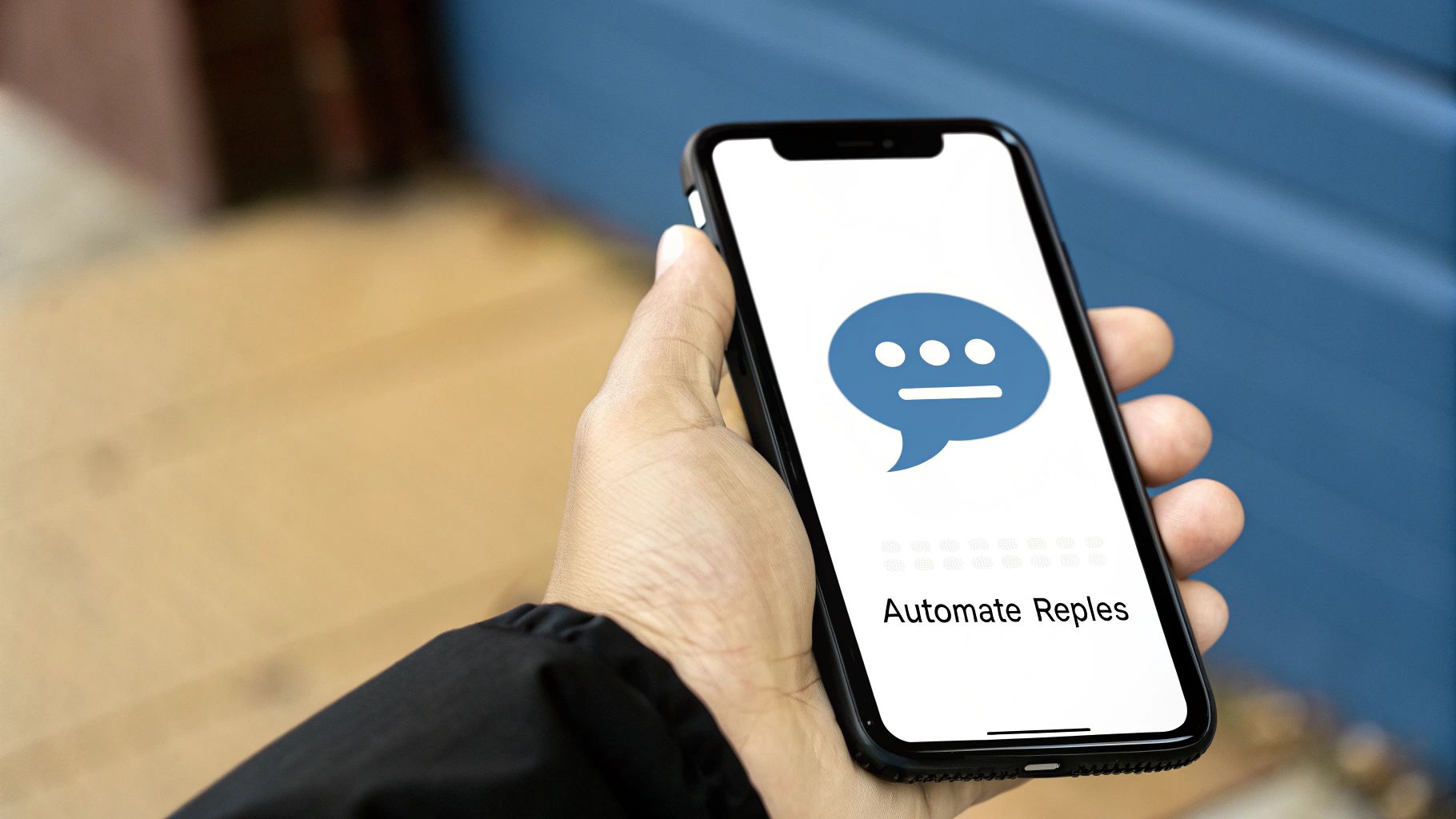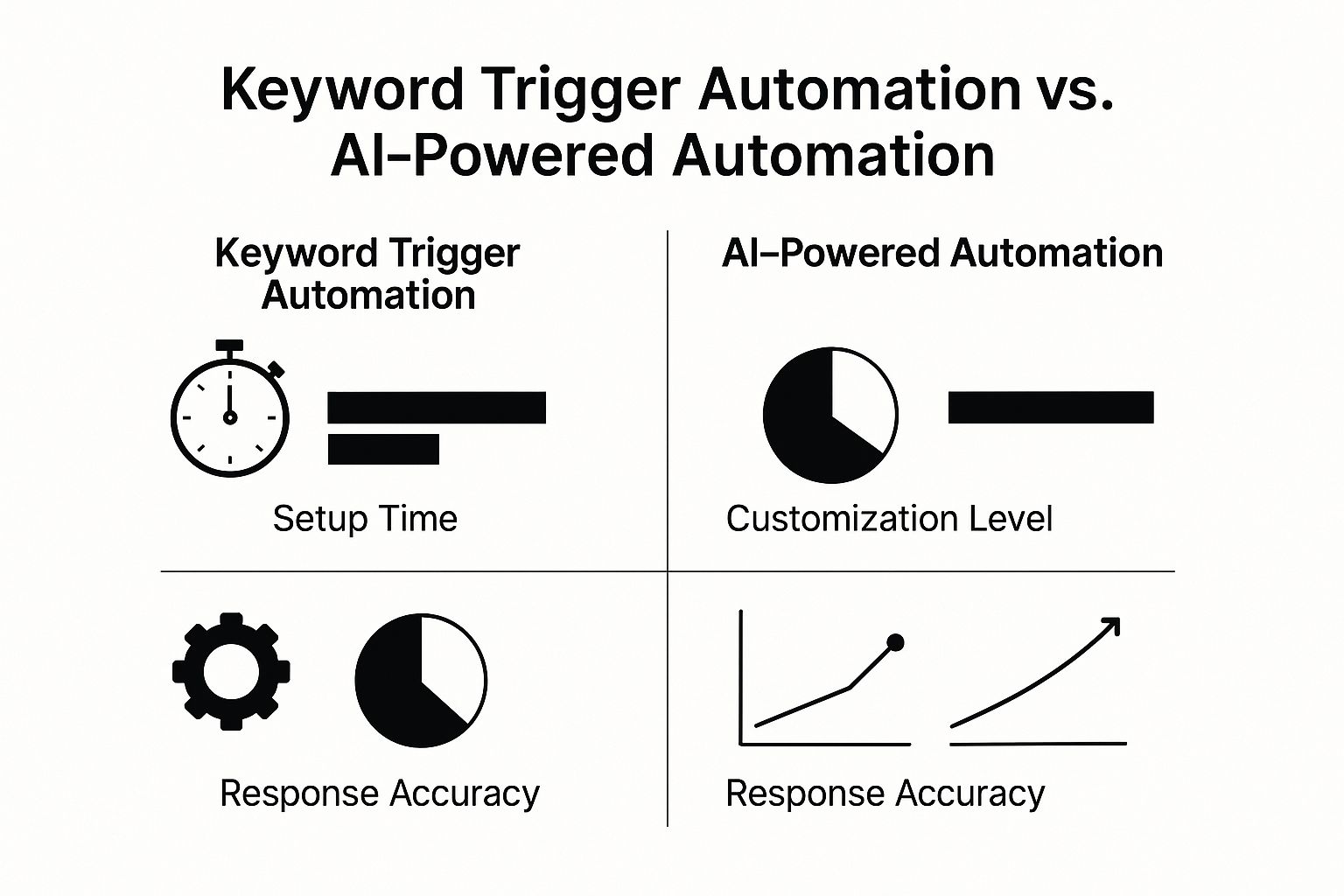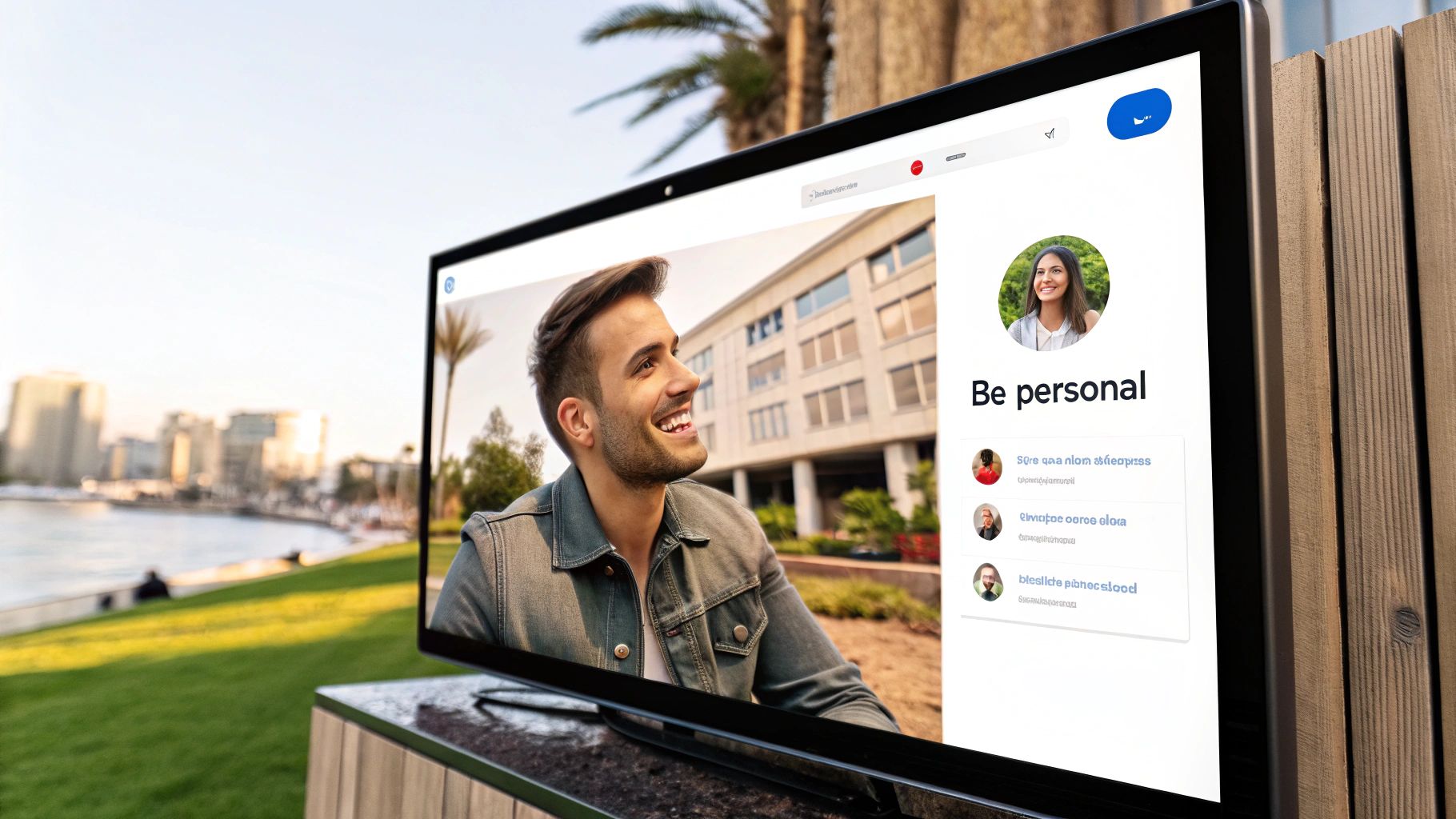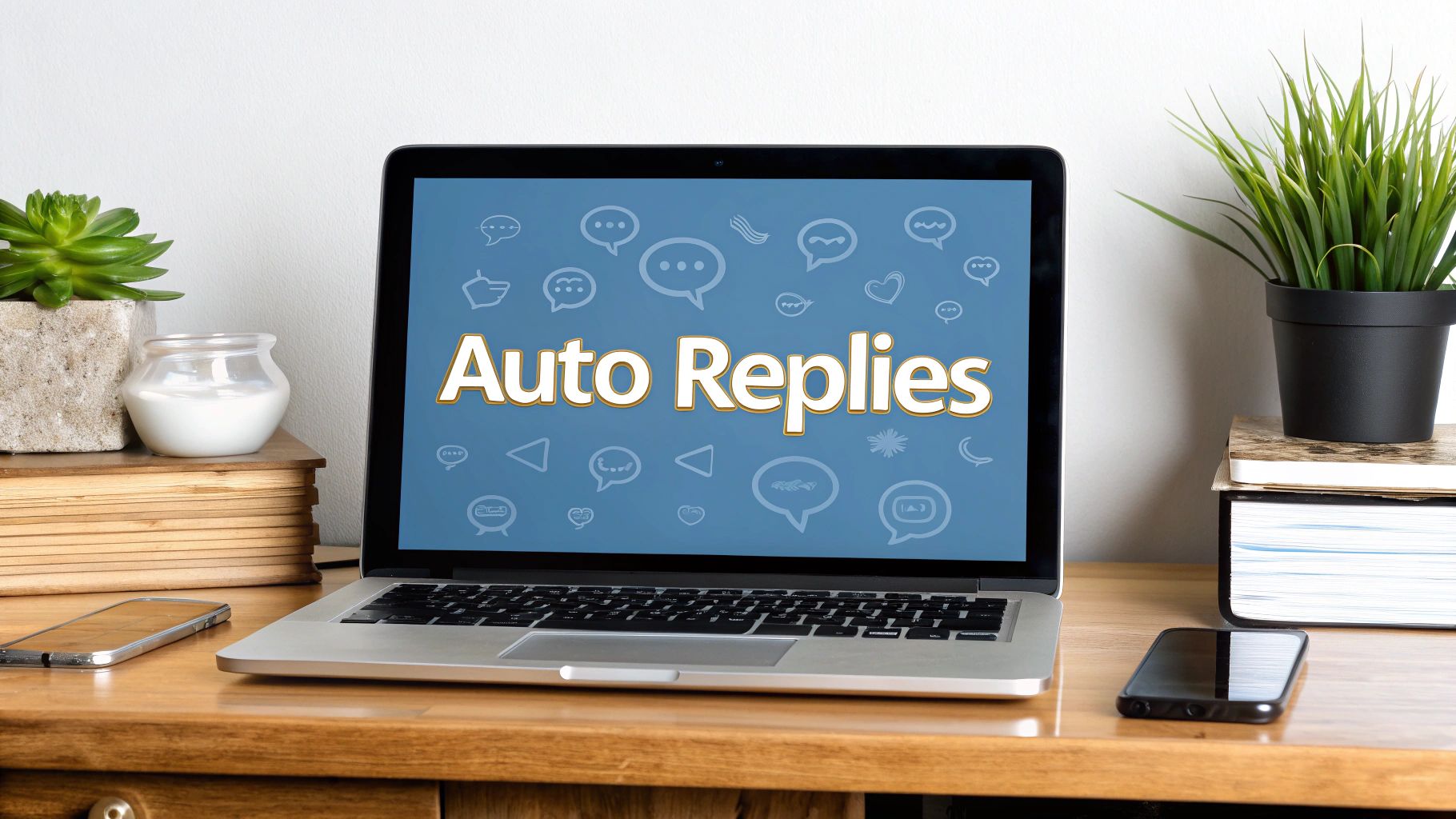The Power and Pitfalls of Automated Twitter Replies

Automated Twitter replies, also known as auto-replies, offer a powerful way to manage your Twitter presence. They allow you to instantly engage with followers, answer common questions, and even guide traffic to your website. Think of a new follower receiving a thank you message, or a user being directed to a helpful resource. This is how auto-replies help scale your engagement efforts.
Benefits of Automated Twitter Replies
Auto-replies offer several distinct advantages for managing your Twitter interactions:
- Increased Response Time: Followers feel valued when they receive immediate acknowledgements.
- 24/7 Availability: You can respond to inquiries and mentions at any time, even outside of regular business hours.
- Consistent Brand Voice: Ensure your initial interactions always reflect your brand identity.
- Scalability: Efficiently handle a high volume of interactions without manual intervention.
- Improved Customer Service: Provide instant support and guidance to those seeking assistance.
However, like any tool, automated replies require careful consideration. Unskillful implementation can make them feel impersonal, even damaging your brand's reputation. Let's explore some potential pitfalls.
Limitations of Automated Twitter Replies
While powerful, auto-replies have limitations that need careful management.
- Generic Responses: Overly broad replies can sound robotic and insincere.
- Misinterpretations: Automated systems can misjudge the context of a tweet, resulting in irrelevant replies.
- Negative Perception: Some users see auto-replies as spam, particularly if they are overly promotional.
- Lack of Personalization: Generic replies won't build genuine connections.
- Over-Automation: Relying solely on automated replies can lead to neglecting real human interaction.
To help you weigh the benefits against the potential drawbacks, let's look at a detailed comparison.
The following table summarizes the pros and cons of using automated Twitter replies:
Automated Twitter Replies: Pros and Cons
| Benefits | Limitations |
|---|---|
| Increased Efficiency | Potential for Impersonal Interactions |
| Improved Response Times | Risk of Misinterpretation |
| 24/7 Availability | Can Appear Spammy |
| Consistent Brand Voice | Limited Personalization |
| Scalability | Over-reliance on Automation |
As the table shows, the effectiveness of auto-replies depends on strategic implementation.
Automated replies are increasingly popular as brands and individuals strive for better audience engagement. However, the average engagement rate per tweet is only about 0.029%. This emphasizes the need for compelling replies that resonate with users and encourage interaction. Despite the challenges, automation can streamline communication, especially for businesses handling many messages. For deeper insights into Twitter statistics, check out Measure Studio - Twitter Statistics.
For tips on maximizing the effectiveness of your automated replies, take a look at this article: How to Master the Twitter Algorithm.
By understanding the nuances of auto-replies, you can harness their power while minimizing the risks. Strategic implementation can lead to effective audience engagement, a more efficient workflow, and an enhanced overall Twitter strategy.
Navigating the Algorithm: Making Your Automated Replies Count

Creating effective automated replies on Twitter involves more than simply scheduling messages. It requires a strategic understanding of the platform's algorithm. This means carefully designing your automated responses to align with the factors that influence visibility and reach. Consider elements like timing, content structure, and overall response patterns. These factors can significantly impact how the algorithm prioritizes your replies and helps you maximize your automated efforts.
Timing Is Everything: Understanding When to Reply
The timing of your automated replies is crucial for their effectiveness. A welcome message sent immediately after a new follower connects with you feels much more personal and welcoming than one sent hours later. This immediate responsiveness can encourage further interaction and build stronger connections with your audience. Therefore, timing optimization is a vital component of your Twitter strategy.
Content Structure: Crafting Replies That Resonate
The structure and content of your automated replies are equally important. Think of each reply as a mini-conversation. Your replies should be concise, engaging, and offer value to the recipient. This could involve incorporating relevant hashtags, asking thought-provoking questions, or providing helpful links. Each interaction should contribute to building a genuine connection.
Additionally, the Twitter algorithm plays a significant role in determining the visibility of your automated replies. The platform considers various factors, including past interactions, trending topics, and user behavior, when ranking Tweets in the "For You" timeline. This algorithm-driven approach emphasizes the importance of aligning automated replies with user interests and preferences. Understanding how the algorithm works allows you to create more effective automated responses that resonate with your target audience. For example, using relevant hashtags and mentioning trending topics can broaden the reach of your automated replies. Learn more about the Twitter Algorithm.
Response Patterns: Avoiding the Spam Trap
While automation is a valuable tool, avoid overly repetitive or generic responses. Such replies can trigger the algorithm to flag your account for spam, ultimately hindering your reach. The key is to strike a balance between automation and personalization. Ensure your automated replies feel authentic and add value to the conversation. This approach will foster genuine engagement and strengthen your Twitter presence.
Practical Frameworks for Algorithmic Alignment
Developing a practical framework for your automation rules is essential. Begin by identifying the specific triggers that will initiate an automated reply. Then, craft several variations of your reply message to introduce variety. This prevents your replies from sounding robotic and increases the likelihood of genuine interaction. How to master Twitter reply engagement. By focusing on these key elements, you can transform your automated replies from simple acknowledgements into valuable tools for community building on Twitter.
Building Your Automated Twitter Reply Infrastructure
Building a solid foundation for automated replies involves carefully selecting the right tools and setting up a system that aligns with your overall Twitter strategy. This requires a clear understanding of the different automation approaches available and how they can be integrated into your existing workflow. For example, consider how automated replies can complement your customer service strategy or enhance your lead generation efforts. Using robust social media automation tools is key to streamlining your process.
Choosing the Right Automation Approach
There are several ways to automate Twitter replies. One popular approach is keyword-triggered automation, where replies are sent based on specific keywords mentioned in tweets. This can be useful for answering common questions or directing users to relevant resources.
Another approach is AI-powered automation. This method leverages artificial intelligence to generate more personalized and contextually appropriate replies. This can be particularly useful for managing complex conversations or providing more tailored support.
The infographic below compares keyword-triggered automation and AI-powered automation across key metrics: Setup Time, Customization Level, and Response Accuracy.

As the infographic shows, Keyword Trigger Automation excels in its quick setup. AI-Powered Automation shines in terms of customization and accuracy, providing more nuanced and relevant replies. This difference highlights the trade-off between speed of implementation and the sophistication of the automated responses. The right approach depends on your specific needs and resources.
To help you choose the best tool for your needs, we've compiled a comparison table of some popular options:
To help you choose the best tool for your needs, we've compiled the following comparison table:
Top Tools for Twitter Reply Automation
Comparison of leading automation tools with their key features and pricing
| Tool Name | Key Features | Best For | Price Range |
|---|---|---|---|
| TweetDeck | Scheduling, multiple account management, real-time tracking | Individuals, small businesses | Free |
| Hootsuite | Content curation, analytics, team collaboration | Small to medium businesses | $49-$739/month |
| SproutSocial | Social listening, reporting, CRM integrations | Medium to large businesses | $249-$499/month |
| Buffer | Publishing, analytics, engagement tools | Individuals, small businesses | $6-$99/month |
This table offers a quick overview of some popular Twitter automation tools. Each tool caters to different needs and budgets, so it's important to research each option thoroughly before making a decision.
Integrating With Your Existing Systems
When building your automation infrastructure, consider how it will integrate with your current customer relationship management (CRM) system. Seamless integration allows you to track customer interactions, manage leads, and provide a more holistic customer experience.
This is essential for ensuring that automated replies are not just isolated interactions but rather a valuable component of your overall communication strategy. For instance, automation can be used to gather initial information from customers and then seamlessly transition them to a human agent for more complex inquiries.
Security and Best Practices
Implementing strong security protocols is crucial for protecting your brand and maintaining the integrity of your Twitter account. Two-factor authentication and regular password updates are fundamental steps in safeguarding your automated systems from unauthorized access. This proactive approach helps prevent potential security breaches and ensures that your automated replies are used responsibly and ethically.
Furthermore, adhering to Twitter's best practices and terms of service is essential when setting up automated replies. Avoid overly promotional or repetitive messages, which can be perceived as spam and negatively impact your account. Focus on providing value to your audience and building genuine connections. This will enhance your Twitter presence and create a positive experience for your followers. Building your automated Twitter reply infrastructure thoughtfully can enhance engagement, improve efficiency, and foster a stronger online community.
Crafting Automated Replies That Feel Genuinely Human

The real strength of automated Twitter replies lies in their ability to connect with users on a personal level. This goes beyond using standard reply templates and involves adopting strategies that resonate with each individual. It's about considering the psychology of your audience and how they interpret automated interactions. Understanding these nuances helps create replies that foster authentic engagement.
Segmenting Your Audience for Targeted Replies
Audience segmentation is a powerful strategy for achieving personalized automated replies. This involves dividing your followers into specific groups based on shared characteristics like interests, demographics, or past interactions. For instance, you could segment your audience by their interest in certain product categories, or by those who have previously interacted with your content. This focused approach allows you to customize your automated replies, making them more relevant and impactful.
Personalization: Turning Templates into Conversations
Personalization is essential for crafting automated replies that resonate with authenticity. While templates are useful for efficiency, incorporating personal details transforms a generic message into a one-on-one interaction. This could involve including the user's name, referencing their past tweets, or mentioning their specific interests. This personal touch demonstrates that you appreciate their engagement and aren't just sending automated responses.
Another effective technique is designing multi-step response flows. Instead of a single automated reply, create a series of messages that guide the user through a conversation. This might include asking follow-up questions, providing extra information, or pointing them toward helpful resources. This interactive strategy encourages meaningful dialogue and strengthens connections.
For the technical aspects of creating automated Twitter replies, this guide offers step-by-step instructions: Twitter Auto Reply Setup Guide.
Examples of Effective Automated Reply Strategies
Many brands are already using these techniques to create engaging automated Twitter experiences. Some companies use automated replies to welcome new followers and offer special discounts. Others use them to answer frequently asked questions and offer immediate customer support. These examples demonstrate the flexibility of automated replies and their potential to enhance your Twitter presence. As of 2025, Twitter (now known as X) has 611 million monthly active users, with a 63% increase in users liking branded content in the latter half of 2023. This underscores the growing importance of automated replies in handling the increasing volume of interactions and building positive brand engagement. More detailed statistics can be found here: Analyzify - X (Twitter) Statistics. By adopting these human-centric approaches, you can ensure your automated replies help create a vibrant and engaged Twitter community.
Measuring What Matters: Tracking Automated Reply Success
Simply setting up automated Twitter replies isn't enough. Understanding their impact and continually refining your approach based on data is what truly drives success. This means looking beyond superficial metrics and focusing on Key Performance Indicators (KPIs) that align with your specific objectives. This section explores how to measure the effectiveness of your automated replies and use data to inform your decisions.
Identifying Key Performance Indicators (KPIs)
The first step towards measuring success is identifying the KPIs that are most relevant to your goals. If your objective is to improve customer service efficiency, metrics like average response time and resolution rate are crucial.
If lead generation is your goal, however, you'll want to focus on metrics like conversion percentages and website clicks originating from automated interactions. Defining these KPIs establishes a clear framework for evaluation.
Implementing Tracking Systems
Once you've identified your KPIs, you need to implement tracking systems to measure them effectively. Many social media management tools like Hootsuite offer built-in analytics dashboards to monitor key metrics related to your automated replies.
These platforms offer valuable insights into response times, engagement levels, and conversion rates. Some tools even allow you to tag specific automated replies, making it easier to track their individual performance.
A/B Testing: Refining Your Automated Replies
A/B testing is a vital technique for optimizing your automated replies. It involves creating different versions of your replies and testing them against each other to determine which performs best.
You could, for example, test different greetings, calls to action, or levels of personalization. This experimental approach enables data-backed decisions and continuous improvement of your automated responses. Even a small change in wording can significantly impact engagement or conversion rates.
Building Analytics Frameworks
Creating a comprehensive analytics framework helps connect your social media automation to tangible business outcomes. This means linking your social media metrics to broader business goals like sales revenue or customer satisfaction.
This integrated approach demonstrates the value of your Twitter efforts and justifies continued investment in automation.
Case Studies in Automated Reply Measurement
Many brands have successfully used automated Twitter replies to achieve their business objectives. Some companies have used auto-replies to significantly reduce customer support response times, while others have leveraged automation to generate leads and drive website traffic.
Analyzing these success stories offers valuable insights and inspiration for your own strategy. Learn more in our article about How to Master Social Media Engagement. Studying how other companies have implemented and measured automated replies helps identify best practices and avoid common pitfalls. This research provides a strong foundation for building a successful automated reply strategy. This data-driven approach helps you optimize your automated replies for maximum impact and achieve measurable results on Twitter.
The Human-Automation Partnership That Drives Results
The most effective Twitter strategies don't rely on choosing between human interaction or automated Twitter replies. Instead, they strategically combine both. Think of it as a coordinated dance: automation handles the predictable steps, allowing humans to add personality and spontaneity. This partnership lets you scale engagement while maintaining genuine connections with your followers.
Designing Transparent Escalation Protocols
Creating a smooth transition between automated responses and human interaction is essential. Imagine a customer asking a complex question needing individual attention. A well-designed system automatically flags this and notifies a human agent. This transparent escalation ensures no question goes unanswered and builds trust with your audience.
For example, configure your automation to escalate conversations if a user mentions specific keywords like "complaint" or "problem." This lets your team quickly address sensitive issues and prevent negative experiences.
Identifying Automation Opportunities
Not all Twitter interactions are the same. Some, like welcoming new followers, are perfect for automation. These predictable interactions benefit from the speed and efficiency of automated replies. This frees your team for higher-value tasks requiring a human touch, like answering complex inquiries and crafting personalized messages.
Other interactions, such as responding to specific user questions or complaints, require human empathy, creative problem-solving, and relationship-building. A framework defining these scenarios allows automation to enhance, not replace, human interaction.
Training Your Team for Hybrid Workflows
Prepare your social media team to work effectively alongside automation tools. This includes training on using the automation platform, interpreting data, and recognizing when human intervention is needed. Think of it like onboarding a new team member. Everyone needs to understand their role and how to collaborate effectively.
This collaborative approach empowers your team to handle more interactions, respond faster, and provide a better overall experience. Furthermore, analyzing data from automated responses provides valuable insights into customer behavior and preferences, informing future social media strategies.
By combining the speed of automation with authentic human connection, you create a powerful Twitter strategy. This hybrid approach helps you connect with more people, build stronger relationships, and achieve greater success on the platform.
Ready to accelerate your Twitter growth and boost engagement without endless manual scrolling and responding? Check out Reply Guy, the Chrome extension designed to pinpoint trending tweets and empower you with AI-driven strategies for organic growth. Get started with Reply Guy today!
